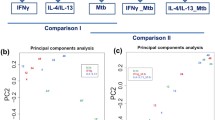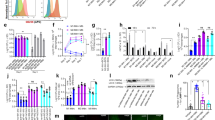Abstract
Objective
Mycobacterium tuberculosis (Mtb), the causative agent of tuberculosis (TB), causes an estimated 1.6 million human deaths annually, but the pathogenesis of TB remains unclear. Immunity plays a critical role in the onset and outcome of TB. This study aimed to uncover the roles of innate and adaptive immunity in TB.
Methods
The gene expression profiles generated by RNA sequencing from human peripheral blood mononuclear cells (PBMCs) stimulated with or without Mtb strain H37Rv antigens were analyzed. A total of 973 differentially expressed mRNAs were identified.
Results
The differentially expressed genes were enriched in innate immunity signaling functions. The mesenchymal-epithelial transition factor (MET) gene was significantly upregulated in CD14+ monocytes. A MET inhibitor improved the uptake of the BCG strain by monocytes and macrophages as well as inhibited the expression of indoleamine 2,3-dioxygenase (IDO). The expression of IDO was increased in PBMCs stimulated with Mtb antigens, and the IDO inhibitor promoted the expression of CD40, CD83, and CD86.
Conclusion
Our results might provide clues regarding the immunomodulatory mechanisms used by Mtb to evade the host defense system.
Similar content being viewed by others
References
WHO. Global Tuberculosis Report 2020. https://www.who.int/publications/i/item/97892400131312020.
Verrall AJ, Schneider M, Alisjahbana B, et al. Early clearance of Mycobacterium tuberculosis is associated with increased innate immune responses. J Infect Dis, 2020,221(8):1342–1350
Jasenosky LD, Scriba TJ, Hanekom WA, et al. T cells and adaptive immunity to Mycobacterium tuberculosis in humans. Immunol Rev, 2015,264(1):74–87
Trusolino L, Bertotti A, Comoglio PM. MET signalling: principles and functions in development, organ regeneration and cancer. Nat Rev Mol Cell Biol, 2010,11(12):834–848
Sagi Z, Hieronymus T. The Impact of the Epithelial-Mesenchymal Transition Regulator Hepatocyte Growth Factor Receptor/Met on Skin Immunity by Modulating Langerhans Cell Migration. Front Immunol, 2018,9:517
Zhang Y, Xia M, Jin K, et al. Function of the c-Met receptor tyrosine kinase in carcinogenesis and associated therapeutic opportunities. Mol Cancer, 2018,17(1):45
Fernandes M, Duplaquet L, Tulasne D. Proteolytic cleavages of MET: the divide-and-conquer strategy of a receptor tyrosine kinase. BMB Rep, 2019,52(4):239–249
Papaccio F, Della Corte CM, Viscardi G, et al. HGF/MET and the Immune System: Relevance for Cancer Immunotherapy. Int J Mol Sci, 2018,19(11):3595
Ilangumaran S, Villalobos-Hernandez A, Bobbala D, et al. The hepatocyte growth factor (HGF)-MET receptor tyrosine kinase signaling pathway: Diverse roles in modulating immune cell functions. Cytokine, 2016,82:125–139
Okunishi K, Dohi M, Nakagome K, et al. A novel role of hepatocyte growth factor as an immune regulator through suppressing dendritic cell function. J Immunol, 2005,175(7):4745–4753
Benkhoucha M, Santiago-Raber ML, Schneiter G, et al. Hepatocyte growth factor inhibits CNS autoimmunity by inducing tolerogenic dendritic cells and CD25+Foxp3+ regulatory T cells. Proc Natl Acad Sci U S A, 2010,107(14):6424–6429
Galimi F, Cottone E, Vigna E, et al. Hepatocyte growth factor is a regulator of monocyte-macrophage function. J Immunol, 2001,166(2):1241–1247
Beilmann M, Vande Woude GF, Dienes HP, et al. Hepatocyte growth factor-stimulated invasiveness of monocytes. Blood, 2000,95(12):3964–3969
Finisguerra V, Di Conza G, Di Matteo M, et al. MET is required for the recruitment of anti-tumoural neutrophils. Nature, 2015,522(7556):349–353
Tamura S, Sugawara T, Tokoro Y, et al. Expression and function of c-Met, a receptor for hepatocyte growth factor, during T-cell development. Scand J Immunol, 1998,47(4):296–301
van der Voort R, Taher TE, Keehnen RM, et al. Paracrine regulation of germinal center B cell adhesion through the c-met-hepatocyte growth factor/scatter factor pathway. J Exp Med, 1997,185(12):2121–2131
Benkhoucha M, Molnarfi N, Kaya G, et al. Identification of a novel population of highly cytotoxic c-Met-expressing CD8(+) T lymphocytes. EMBO Rep, 2017,18(9):1545–1558
Baek JH, Birchmeier C, Zenke M, et al. The HGF receptor/Met tyrosine kinase is a key regulator of dendritic cell migration in skin immunity. J Immunol, 2012,189(4):1699–1707
Kurz SM, Diebold SS, Hieronymus T, et al. The impact of c-met/scatter factor receptor on dendritic cell migration. Eur J Immunol, 2002,32(7):1832–1838
Hmama Z, Pena-Diaz S, Joseph S, et al. Immunoevasion and immunosuppression of the macrophage by Mycobacterium tuberculosis. Immunol Rev, 2015,264(1):220–232
Weiss G, Schaible UE. Macrophage defense mechanisms against intracellular bacteria. Immunol Rev, 2015,264(1):182–203
Suzuki Y, Suda T, Asada K, et al. Serum indoleamine 2,3-dioxygenase activity predicts prognosis of pulmonary tuberculosis. Clin Vaccine Immunol, 2012,19(3):436–442
Blumenthal A, Nagalingam G, Huch JH, et al. M. tuberculosis induces potent activation of IDO-1, but this is not essential for the immunological control of infection. PLoS One, 2012,7(5):e37314
Gautam US, Foreman TW, Bucsan AN, et al. In vivo inhibition of tryptophan catabolism reorganizes the tuberculoma and augments immune-mediated control of Mycobacterium tuberculosis. Proc Natl Acad Sci U S A, 2018,115(1):E62–E71
Author information
Authors and Affiliations
Corresponding author
Ethics declarations
The authors declare no conflicts of interest.
Additional information
This study was supported by the Thirteen-Fifth Mega-Scientific Project on “Prevention and Treatment of AIDS, Viral Hepatitis and Other Infectious Diseases” (No. 2017ZX10201301-007-002), the National Natural Science Foundation of China (No. 81571961 and No. 82072233), and the 309th Hospital (No. 2017ZD-007).
Rights and permissions
About this article
Cite this article
Yang, Bf., Zhai, F., An, Hj. et al. Mesenchymal-epithelial Transition Factor Regulates Monocyte Function during Mycobacterial Infection via Indoleamine 2,3-dioxygenase. CURR MED SCI 42, 407–416 (2022). https://doi.org/10.1007/s11596-022-2518-3
Received:
Accepted:
Published:
Issue Date:
DOI: https://doi.org/10.1007/s11596-022-2518-3




